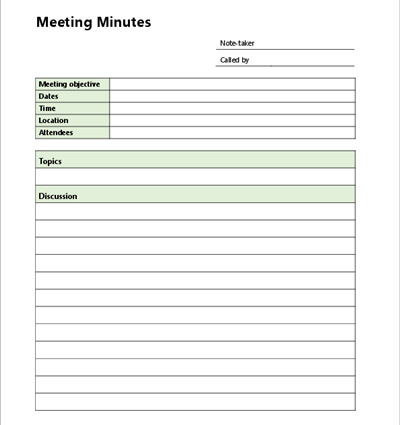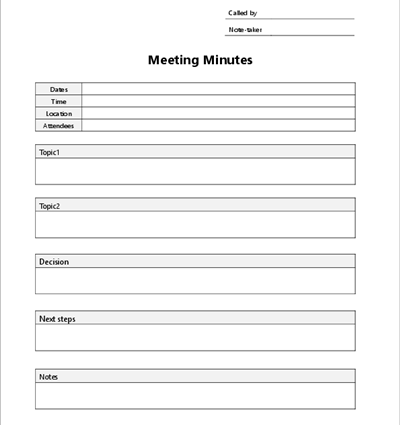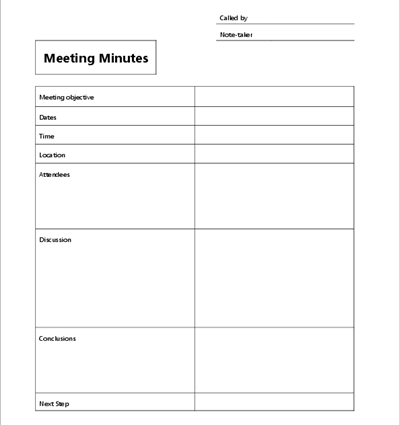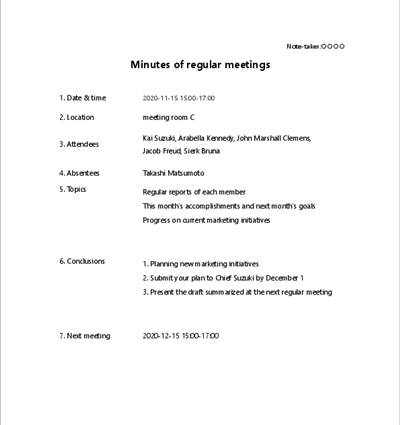
Many people have never been taught how to write minutes at work. However, taking minutes is very important in terms of keeping a record of your meetings and sharing them with your team members. In this article, we'll discuss meeting minutes templates and how to write them.
By learning about meeting minutes templates and how to write them, you can solve the problems of "I'm new to taking minutes, but I don't know how to write them" and "I want to standardize the format of the minutes in my company.
Meeting minutes templates
You can download free Minutes Templates for internal and external meetings. There are Word versions of the minutes, from simple ones without colors to more stylish ones with designs and colors to match the format of your company's regulations and projects.
How to use the template
- Sample image Click to view a larger image.
- The template can be downloaded from the download page.
- It is available for download in word format.
What are the Meeting Minutes?
Minutes are documents that record the content, attendees, and decisions made during meetings, conferences, and meetings. How much detail to include in the minutes depends on the company's policies and objectives.
The purpose of the minutes
Before you learn how to write minutes, let's review the purpose of the minutes. Minutes are written text to record the content and decisions of a meeting or meeting.
When it comes to the content and decisions of a meeting, it's easy to think, "I don't need minutes because the people who were present know everything," but the purpose of minutes is to share them with those who were absent or to record them so that they can be remembered later if they are forgotten.
- To help you remember the content of the meeting later
- Share it with people who are not present at the meeting
Formatting the Minutes
There is no fixed format or format for the Meeting Minutes. You can use the items and format required by the company, but to some extent, there are certain items that are commonly used in minutes. There are certain items that are commonly used in the minutes.
You can create your own minutes efficiently by learning the general format and format of the minutes first and then adding the items you need for your company.
Needed items for the minutes
Called by
Notes-taker
Summary
Date and time
Location
Attendees
Agenda
Contents
Decisions
ToDo
Remarks
Attachments
Next Appointment
Next Scheduled Date and Time
What to expect next time
Approval column
Called by
The name of the person who prepared these meeting minutes.
Notes-taker
Mention the name of the person who took the minutes.
Summary
Provide a brief description of the content of the meeting, what kind of meeting it is.
Date and time
The date the meeting took place. Include the time of the meeting, if applicable.
Location
Where the meeting took place.
Attendees
List the names of those who attended the meeting. If there seems to be a large number of people, take up an extra slot.
Agenda
What will be discussed at the meeting. If there is more than one, list it because it can be one thing or multiple things.
Content
Describe what was discussed at the meeting.
Brief bullet points are easier to read later than lengthy written descriptions. If decisions are described in a separate column, they should be content only, not decisions.
Decisions
Finally, summarize the conclusions reached in the meeting. Sometimes no conclusions are reached, so it is useful to write down what was decided or not decided, so that you can look back at it later.
ToDo
Describe who is going to do what and by when in response to the outcome of the meeting.
Remarks
Write down any items that you did not include in the content or decisions here. You don't have to do this, but it's more convenient if you have something you want to add later.
Attachments
Describe the materials submitted to the meeting, if any.
Next scheduled date and time
If the meeting is scheduled to be held next time, please indicate the date and time.
Next meeting to be held
If you know the content of the next meeting, fill in the form.
Approval column
Approval column for having your supervisor approve the contents of the minutes.
How to write minutes and tips
Writing minutes in meetings and conferences is very important. Writing minutes can achieve the following objectives
- Align the perceptions of those attending the meeting
- Communicate the content to those who did not attend the meeting
- Decisions made at the meeting can be referenced later
Writing Tip 1: Make the formatting consistent
If there is no internal format for minutes, it is common for each recorder to write the minutes in a format they are comfortable with.
If the minutes are written in different formats, they may not only be difficult to read when reviewing them later, but may also lack the necessary items.
Writing Tip 2: Be clear on the purpose
If you are clear on the purpose of the meeting, it will be easier to understand what the minutes are about and what the outcome will be when you read them later on.
It's not uncommon to have a meeting that goes on for hours but ends up not knowing what the meeting was about. To avoid repeating what was said in the previous meeting, you can avoid wasting time by clearly stating the theme and purpose of the next meeting.
Writing Tip 3: Confirm on the spot if you're unsure about something
Minutes with many unclear points are just as difficult to read later on as if you hadn't taken them.
If you are taking minutes, you may be so absorbed in writing that you miss something, or you may continue to write without understanding what is on the agenda. Since it is easy to forget later, write the minutes on the spot and check the unclear points.
Summary
In this article, we've introduced the writing style, format and template for the minutes. The important thing about minutes is that they are
- Unify the format in the company
- Be clear on the purpose of the meeting
- Check on the spot for discrepancies
There are three things you can do. By keeping these points in mind, you will be able to share the purpose and results of the meeting and avoid meetings where all you can do is time and not know what has been decided.
As for meeting minutes formats and templates, you can download them for free here as well, to help you create a uniform set of minutes for your company.












